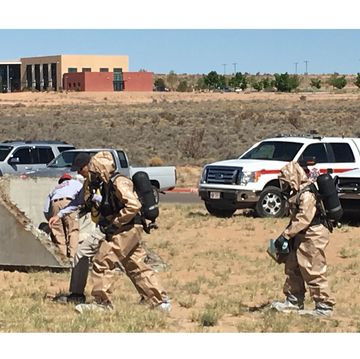An Immersive Journey to Learn Navajo Health Practices

SRMC Training for Changing Emergency Management Landscape
First and last, hospital administrators know the emphasis must always be on providing good patient care - even when the unthinkable happens.
"That is always the first thing in our minds when planning any emergency training exercise," says Jess Lewis, emergency manager at The University of New Mexico Sandoval Regional Medical Center (SRMC). "Whatever the emergency scenario, our training has to have the goal of ensuring patient safety."
The list of possible calamities is endless. What happens in the event of an explosion? How to you get patients down the stairs? Where will you take ICU patients if the entire city is in crisis? What happens if you hear gunshots in a hallway?
Lewis joined SRMC a year ago after 25 years at the Sandoval County Regional Fire Department, where he served as deputy chief of Fire Operations and Emergency Management.
Since Lewis's arrival, there have been a number of tabletop exercises and drills, beginning with active shooter scenarios. "Fires" have been set. Smoke has been invoked. "Patients" have been transported up and down in stairwells.
But it has been the collaborations with other area agencies that have provided the most complex and challenging exercises.
"Emergency Management is always driven by two things," Lewis says. "One is the need to protect people and the second are the requirements themselves for training. Everyone - from fire and police to the hospital, is monitored by different agencies.
"Having multiple agencies, each with slightly different regulatory requirements, means planning the process becomes more intricate, but it also creates an opportunity for a training exercise that is more complex - and more realistic."
In a recent countywide event, the hospital joined forces with the Rio Rancho, Sandoval County and Corrales fire departments as well as the National Guard.
The scenario began with a disgruntled employee creating a dirty bomb. First, however, she exploded a small conventional bomb in an out-of-the-way hallway - crippling needed utilities.
"That exercise met so many needs that day that people don't realize," Lewis says.
Plans are in the works for another multi-agency exercise in June, where alternative scenarios of events that might affect Rio Rancho's annual Pork and Brew celebration will be played out.
"It is great to see how representation from the different agencies adds value to these exercises," Lewis says. "We plan levels to levels to levels, so that different levels of administrators were called in."
Lewis sees the next evolutionary step as collaborating with specialty hospitals and nursing hospitals in training exercises.
"Think about if you were to have something critical happen at SRMC. Would have the beds and doctors? If not, then who would need to be trained to receive our patients if we had to transfer people out of the hospital?"
Answering those questions through emergency training can only translate into better care, Lewis says. "In the end, that training can only translate into better patient care."